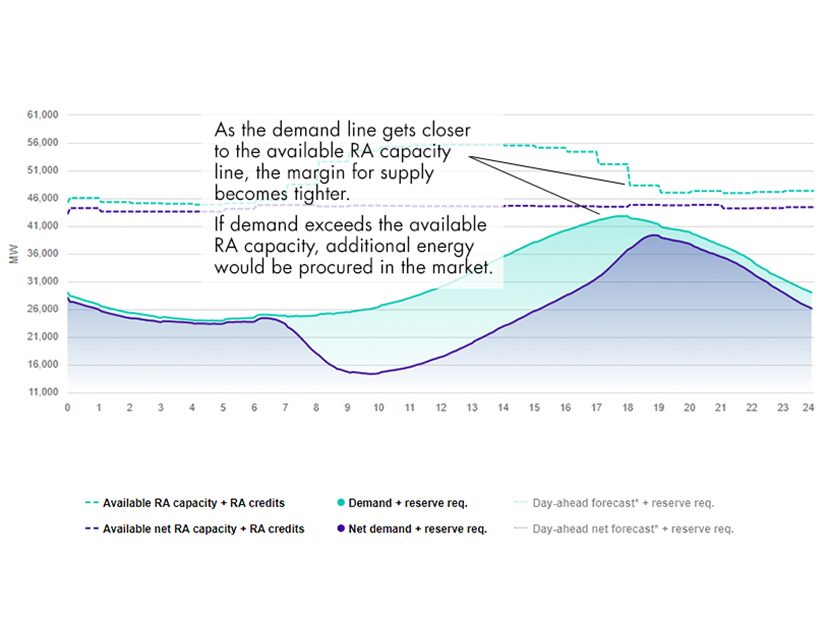CAISO on Nov. 18 kicked off a Resource Adequacy Modeling and Design “workshop” designed to reevaluate and refine several mechanisms the ISO uses to ensure resource adequacy.
The workshop builds on the ISO’s RA Modeling and Program Design working group, in which staff and ISO stakeholders highlighted problem statements associated with the RA program. It aims to continue refining solutions to the problems identified and develop policy responses.
The main goal of the effort is to update the default counting rules and planning reserve margin (PRM), evaluate the need for the Resource Adequacy Availability Incentive Mechanism (RAAIM) or an unforced capacity mechanism (UCAP), and reevaluate outage and substitution rules and the capacity procurement mechanism (CPM), also referred to as the “backstop.”
The issues will be addressed in the three different tracks, but ISO staff noted the tracks can be combined or changed based on stakeholder feedback.
Track one addresses modeling, default rules and accreditation, while track two deals with outage substitution and availability and performance incentive mechanisms. Track three tackles visibility and backstop.
The workshop will be further divided into three “packages” that outline workflow. Package one identifies minimal changes needed to take the first step in addressing the topic, package two outlines forward planning and package three covers operational measures.
The packages are “illustrative” and not representative of CAISO’s preferred or final approach, said Partha Malvadkar, principal of RA and infrastructure policy at the ISO.
“What we’re looking for as we work towards policy development is packages of changes that make sense together and that are achieving the goals and objectives that came out of the working group process in a comprehensive and consistent manner,” Malvadkar said.
PRM and Default Counting Rules
Another central aim of the initiative is to evaluate how well PRMs and counting rules set by local regulatory authorities (LRAs) reflect forced outage rates, performance and availability. Evaluating the need for UCAP, which was discussed in the prior initiative, fits into this area. (See CAISO Considers Replacement of RA Incentive Program.)
“In response to potentially changing regulatory structures at the CPUC (including the scoping of UCAP), CAISO has an opportunity to establish alternatives to the current resource counting design and eliminate/redefine availability and performance incentives while acknowledging LRA authority to establish counting rules,” according to a presentation from the meeting.
The ISO also identified the need to update the PRM based on changes in the RA resource mix and evolving reliability needs within the CAISO balancing authority area (BAA). CAISO policy developer Ansel Lundberg identified that qualifying capacity values, also referred to as “counting rules,” should reflect the relative contribution of different resource types to maintain BAA-wide and local reliability and to meet at least a 0.1 LOLE.
The initiative also addresses the need for capability testing to account for seasonal resource availability. According to Lundberg, the availability of resources based on varying seasonal ambient derates is not consistently reflected in resource net qualifying capacity (NQC), which poses challenges for grid operations. CAISO thinks it should adopt minimum requirements so it can rely on capacity to perform consistent with accreditation in a given season. Such requirements could minimize partial forced outages that derate resources below their NQC value during critical periods.
Outages and Substitution
CAISO also intends to work to establish a more efficient process for outages and substitution. Central to that is developing a voluntary planned outage substitution pool, where scheduling coordinators can make capacity available and pay for it if needed. SCs could also procure from the pool.
The ISO is also considering developing a planned outage buffer provided by each LRA, as well as moving to annual or seasonal showings, CAISO lead policy developer Anja Gilbert said.
The final intent of this track is to remove planned outage substitution requirements and replace them with strong incentives and better information about periods of risk.
RAAIM Reform
RAAIM is one such incentive mechanism that could help remove planned outage substitution requirements. But the ISO is considering revising RAAIM to become a “pay-for-performance” mechanism for capacity to respond and non-capacity resources to be available during scarcity conditions.
That model, which has been implemented in PJM and ISO-NE, acts as both a reward and penalty relative to a resource’s obligation during scarcity events. If a supplier’s poor performance contributes to reliability risk, it could face “strong consequences,” according to Lundberg’s presentation.
Backstop and Visibility
A central component of the prior and current RA initiatives within the ISO is the need for more visibility into RA and non-RA resources. (See CAISO’s Capacity Procurement Mechanism Inefficient, Stakeholders Say.) CAISO’s lack of visibility into the “not-shown” RA fleet makes the backstop mechanism less efficient, but regular reporting on the status of RA capacity could improve the system, said CAISO lead policy develop Hilary Staver.
The ISO suggested options for policy reform, including updating CPM authority to accommodate the backstop based on an assessment of energy sufficiency and/or net peak needs.
“We’re looking to provide visibility into RA and non-RA resources in order to allow for efficient decision making in CAISO operations, obtaining capacity with the right attributes when and where it’s needed, and trying to be efficient and effective in our backstop approach,” Staver said.


